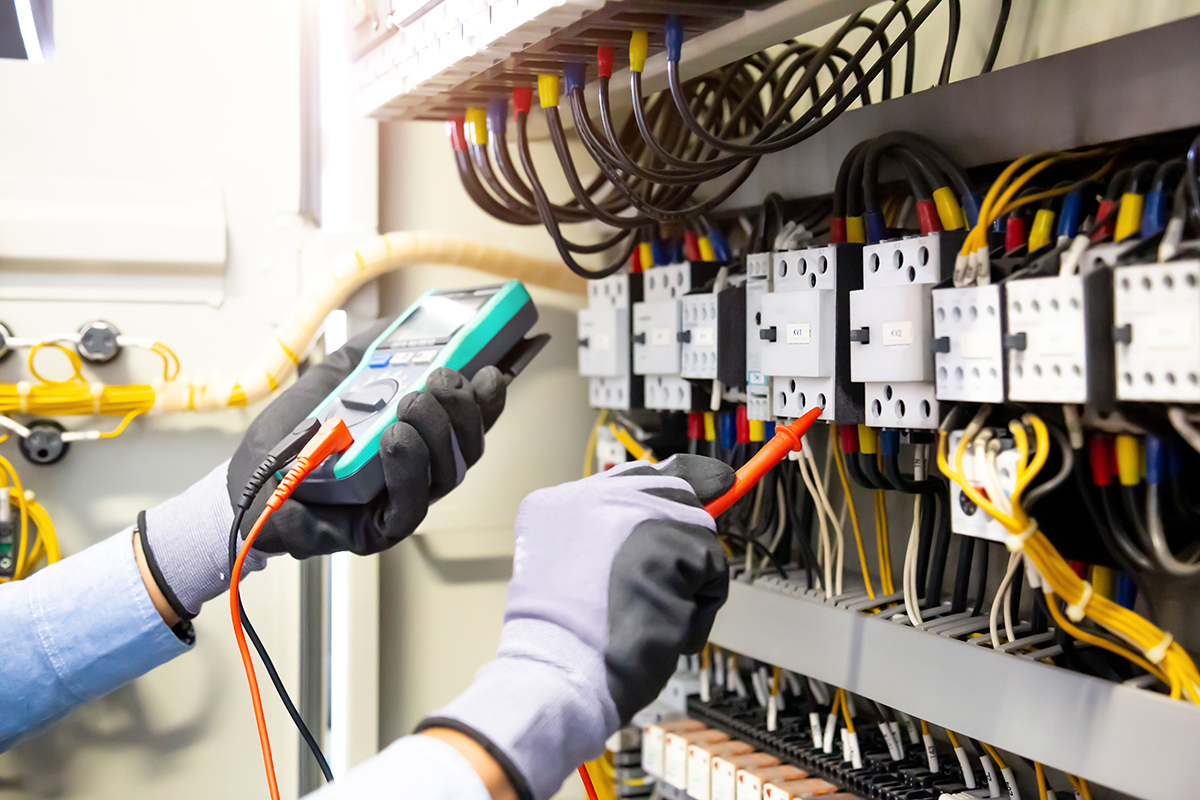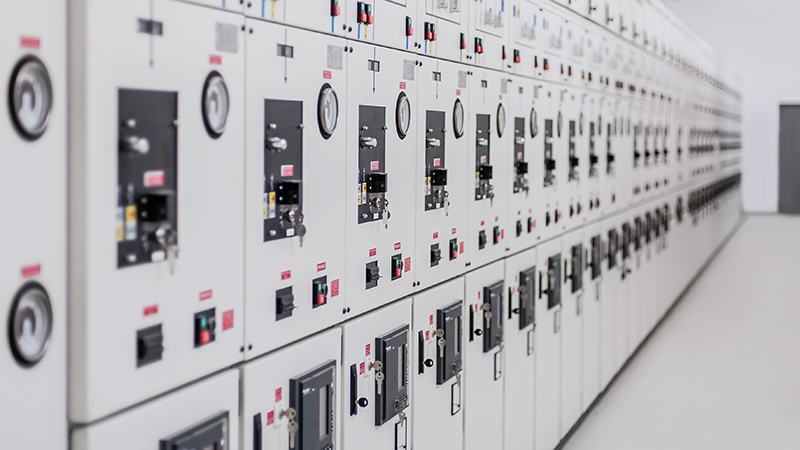What is Switchgear? Your Guide to Circuits and Switchboards

Published: Friday, 05 May 2023
With every electrical output, there must be high levels of protection and control involved. This is why circuits and switchboards are the perfect match, but how exactly do switchboards work? And how do they compare to a switchgear?
What is switchgear?
In simple terms, switchgear is a powerhouse for controlling, regulating and switching the electrical circuit on or off in an electrical emergency, ensuring safety for the user and protection of faults from other circuit components.
Switches, fuses, circuit breakers, isolators, relays, current and potential transformers, indicating instruments, lightning arresters and control panels are all examples of switchgear devices.
How do switchgears work?
Switchgear systems are directly linked to supply systems which are placed in both the high and low-voltage side of the power transformer. When a fault occurs, switchgears de-energize these power transformers for testing and maintenance - working to clear the fault.
This is crucial to the circuit as when a fault occurs, heavy current flows through the equipment, which can result in components getting damaged and the service getting interrupted.
During the de-energizing process, the automatic protective switchgear consists of the relay and circuit breaker - the relay will come into operation and close the trip circuit of the breakers, which disconnects the faulty section; allowing the healthy section to continue to supply electricity as usual, meaning that no damage to equipment occurs, with no complete interruption of supply.
Switchgear VS Switchboards
Switchgear and switchboards are both crucial components of electrical power distribution systems, but they serve different purposes and have distinct features. Here is a comparison between the two:
Switchgear:
Purpose: Switchgear is primarily designed to protect and control electrical equipment in a power system by managing the flow of electricity, isolating faulty equipment, and preventing damage due to faults or overloads.
Components: Switchgear assemblies typically include circuit breakers, disconnect switches, fuses, relays, and control panels. These components work together to monitor and control the electrical network.
Voltage Levels: Switchgears are used in a wide range of voltage levels, from low voltage (LV) to high voltage (HV) applications, and can be found in industrial, commercial, and utility settings.
Fault Interruption: Switchgear is designed to handle high levels of fault current and can interrupt the flow of electricity during fault conditions to protect the power system.
Maintenance: Switchgear components, particularly circuit breakers, often require regular maintenance to ensure reliable operation.
Switchboards:
Purpose: Switchboards are primarily designed to distribute electrical power to various circuits and loads within a facility. They serve as a central hub for routing and managing electricity from the main power source to individual circuits.
Components: Switchboards typically consist of panelboards, distribution boards, or load centres, which house circuit breakers or fuses, along with metering and monitoring devices.
Voltage Levels: Switchboards are mainly used for low voltage (LV) applications, such as in residential, commercial, and light industrial settings.
Fault Interruption: While switchboards may include protective devices like circuit breakers or fuses, they are generally not designed to handle the same level of fault current as switchgear.
Maintenance: Switchboards generally require less maintenance compared to switchgear, as their components are often simpler and more easily accessible.
In summary, switchgear is primarily focused on protecting and controlling electrical equipment in HV applications and power systems, while switchboards are designed for distributing power to various circuits and loads in LV applications. Due to switchgears typically handling higher voltage levels and fault currents compared to switchboards, its components require more maintenance.

Types of switchgear
Switchgear can be classified into different types based on various criteria, such as the insulation medium, voltage level, and application. Here are some common types of switchgear:
1. Based on insulation medium:
Air-Insulated Switchgear (AIS):
Air-insulated switchgear uses air as the primary dielectric medium for insulation and arc quenching. AIS is a traditional and widely used switchgear technology, particularly for medium voltage (MV) and high voltage (HV) applications.
Gas-Insulated Switchgear (GIS):
Gas-insulated switchgear uses sulphur hexafluoride (SF6) gas as the primary insulation and arc-quenching medium. GIS is compact, offering significant space savings compared to AIS, and is well-suited for indoor, underground, or outdoor installations with space constraints. It is commonly used in medium and high-voltage applications.
Solid-Insulated Switchgear (SIS):
Solid-insulated switchgear utilises solid insulation materials, such as epoxy or silicone, to provide dielectric and arc-quenching properties. SIS is typically used in low voltage (LV) and medium voltage (MV) applications and offers a compact and environmentally friendly alternative to AIS and GIS.
Vacuum-Insulated Switchgear (VIS):
Vacuum-insulated switchgear uses vacuum interrupters for arc quenching and insulation. VIS is commonly used in medium voltage applications, offering advantages such as low maintenance, high switching frequency, and minimal environmental impact.
2. Based on voltage level:
Low Voltage Switchgear (LV Switchgear):
Used for voltage levels up to 1 kV, low-voltage switchgear is typically found in residential, commercial, and light industrial settings. It often includes components like circuit breakers, contactors, relays, and fuses.
Medium Voltage Switchgear (MV Switchgear):
Medium voltage switchgear is designed for voltage levels ranging from 1 kV to 36 kV. It is used in various applications, including distribution substations, industrial facilities, and commercial buildings. MV switchgear components include vacuum or gas-insulated circuit breakers, load break switches, and protective relays.
High Voltage Switchgear (HV Switchgear):
High-voltage switchgear is used for voltage levels above 36 kV, typically in utility substations and transmission networks. HV switchgear components include gas-insulated or air-insulated circuit breakers, disconnect switches, and surge arresters.
3. Based on application:
Industrial Switchgear:
Used in manufacturing facilities, processing plants, and other industrial settings, industrial switchgear is designed to manage and protect electrical equipment used in industrial processes.
Utility Switchgear:
Utility switchgear is used in power generation, transmission, and distribution applications to control and protect the electrical network, ensuring the reliable delivery of electricity to consumers.
Commercial Switchgear:
Commercial switchgear is used in office buildings, shopping centres, and other commercial properties to distribute power and protect electrical equipment from faults or overloads.
Residential Switchgear:
Residential switchgear is used in homes and apartment complexes to distribute electricity to individual circuits and protect electrical equipment from faults or overloads.

Medium V low V high switchgear
Wondering what level of voltage you will need to power a specific appliance or space? In this section, we will be explaining the different voltage-level switchgears that are available, including what they are typically used for.
1. Low Voltage (LV) Switchgear:
Voltage Range: Low voltage switchgear is designed for voltage levels up to 1 kV.
Applications: Typically used in residential, commercial, and light industrial settings.
Components: Common components include circuit breakers, contactors, relays, fuses, and metering devices.
Insulation: Often uses air or solid insulation, with some modern designs employing vacuum interrupters for circuit breakers.
Protection: Mainly focused on protecting electrical equipment from short circuits, overloads, and ground faults.
Medium Voltage (MV) Switchgear:
Voltage Range: Medium voltage switchgear is designed for voltage levels ranging from 1 kV to 36 kV.
Applications: Commonly used in distribution substations, industrial facilities, and commercial buildings.
Components: Typical components include vacuum or gas-insulated circuit breakers, load break switches, and protective relays.
Insulation: Often uses air, gas (SF6), solid, or vacuum insulation, depending on the design and application.
Protection: Provides protection for electrical equipment against short circuits, overloads, ground faults, and other abnormal conditions.
High Voltage (HV) Switchgear:
Voltage Range: High voltage switchgear is designed for voltage levels above 36 kV.
Applications: Primarily used in utility substations and transmission networks.
Components: Common components include gas-insulated or air-insulated circuit breakers, disconnect switches, and surge arresters.
Insulation: Typically employs gas (SF6) or air insulation, with gas-insulated switchgear being the more common choice due to its compact design and superior performance.
Protection: Focuses on protecting the electrical network and ensuring the stability and safety of the power system during fault conditions.
Key terms: switchgear glossary guide
Here's a glossary of key terms related to switchgear that you may find helpful:
Circuit Breaker: An automatic switch designed to interrupt the flow of current in an electric circuit to protect electrical equipment from damage caused by faults or overloads.
Disconnect Switch (Isolator): A manual or remotely operated switch used to isolate electrical equipment for maintenance, inspection, or repair.
Fuse: A protective device that melts or breaks when the current exceeds a specified limit, interrupting the electrical flow and protecting the system from damage.
Relay: A device used to detect and identify faults in the power system, sending a signal to the circuit breaker to interrupt the flow of electricity.
Control Panel: The central hub of a switchgear system, housing the necessary instrumentation, monitoring, and control devices.
Air-Insulated Switchgear (AIS): Switchgear that uses air as the primary dielectric medium for insulation and arc quenching.
Gas-Insulated Switchgear (GIS): Switchgear that uses sulphur hexafluoride (SF6) gas as the primary insulation and arc-quenching medium.
Solid-Insulated Switchgear (SIS): Switchgear that utilises solid insulation materials, such as epoxy or silicone, to provide dielectric and arc-quenching properties.
Vacuum-Insulated Switchgear (VIS): Switchgear uses vacuum interrupters for arc quenching and insulation.
Load Break Switch: A switch used to disconnect or connect a load to a power source, typically used in medium voltage switchgear.
Surge Arrester: A device used to protect electrical equipment from voltage surges, such as those caused by lightning or switching operations.
Busbar: A conductor used to distribute electrical power in switchgear, typically made of copper or aluminium.
Current Transformer (CT): A device used to measure the current in a power system by producing a secondary current proportional to the primary current, used for metering and protection purposes.
Voltage Transformer (VT) or Potential Transformer (PT): A device used to measure the voltage in a power system by producing a secondary voltage proportional to the primary voltage, used for metering and protection purposes.
Protection Scheme: A coordinated set of relays, circuit breakers, and other devices designed to detect and isolate faults in a power system, preventing damage to equipment and ensuring system stability.
Arc Quenching: The process of extinguishing an electrical arc during a fault, typically achieved through the use of an insulating medium or by creating a sufficient distance between the contacts.
Short Circuit: An abnormal electrical condition in which a low resistance path is created, leading to a high current flow that can cause equipment damage and system instability.
Overload: An abnormal electrical condition in which the current exceeds the rated capacity of a circuit or device, potentially causing overheating or damage.
Ground Fault: An abnormal electrical condition in which an unintended path to the ground is created, resulting in a leakage current that can cause equipment damage and pose a safety risk.
Fault Current: The high current that flows during a short circuit, overload, or ground fault, which can damage electrical equipment and cause system instability if not interrupted by a protective device.

Looking for a suitable switchgear?
From LV to HV, changeover switches to surge protection enclosures, you can always rely on YESSS Electrical to find you a switchgear that will keep your circuit safe and durable for years to come. Explore the extensive range here.
Have any further questions? Our friendly experts are happy to help - contact the team now.

